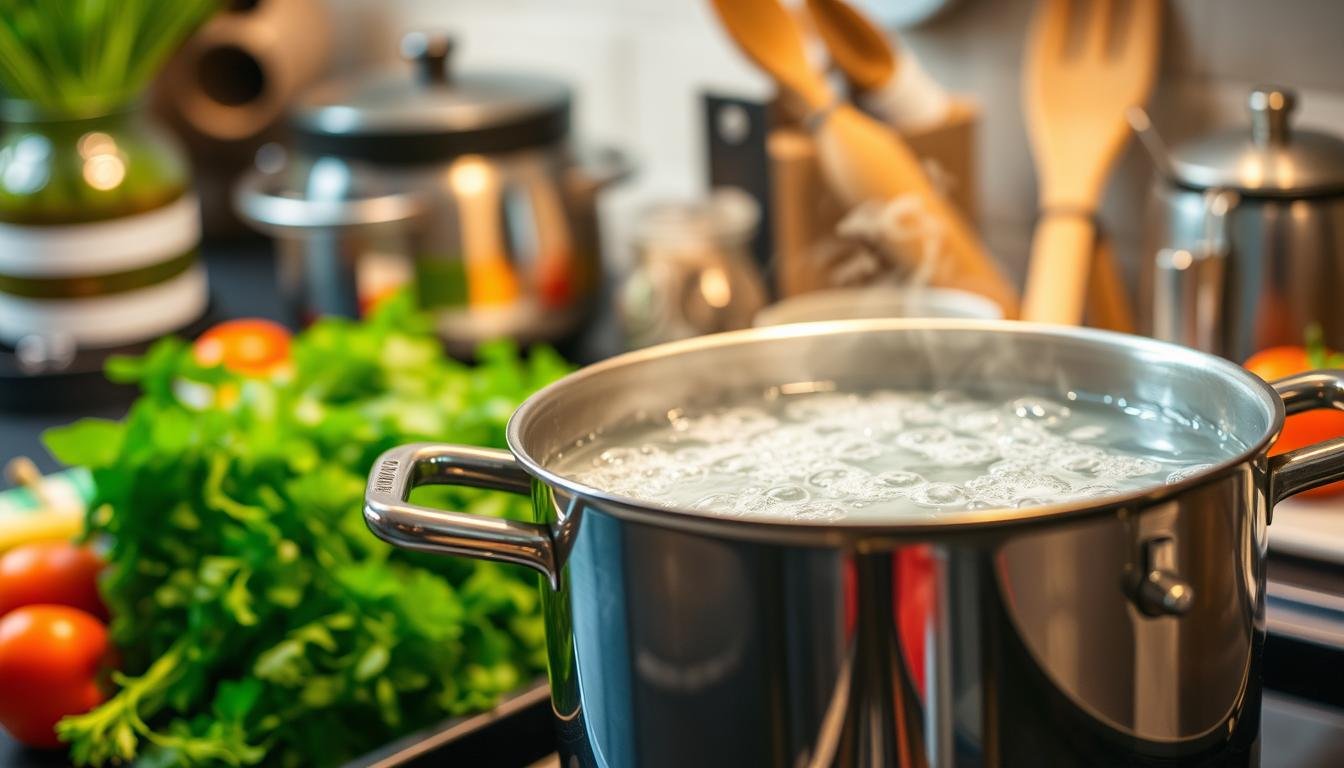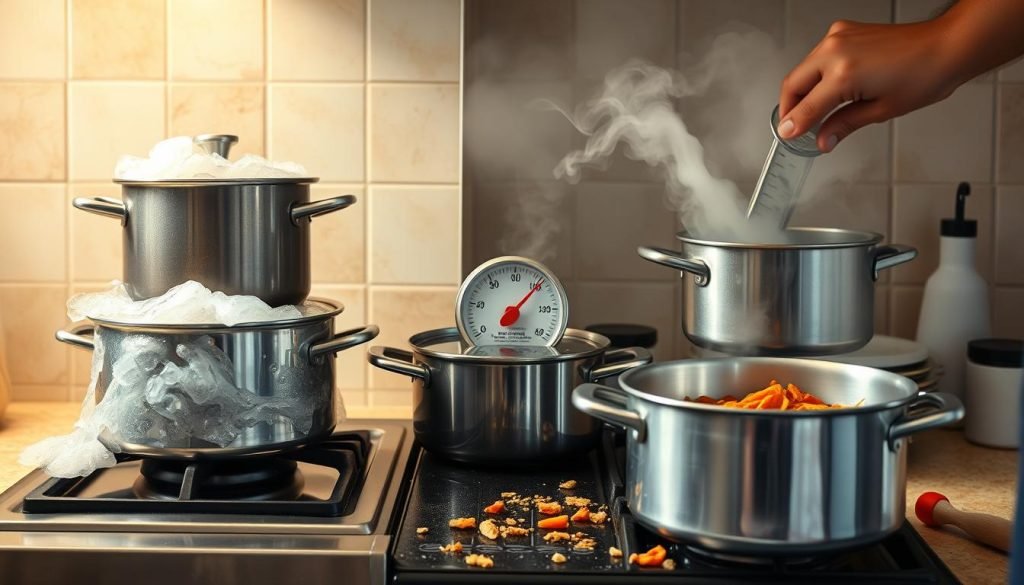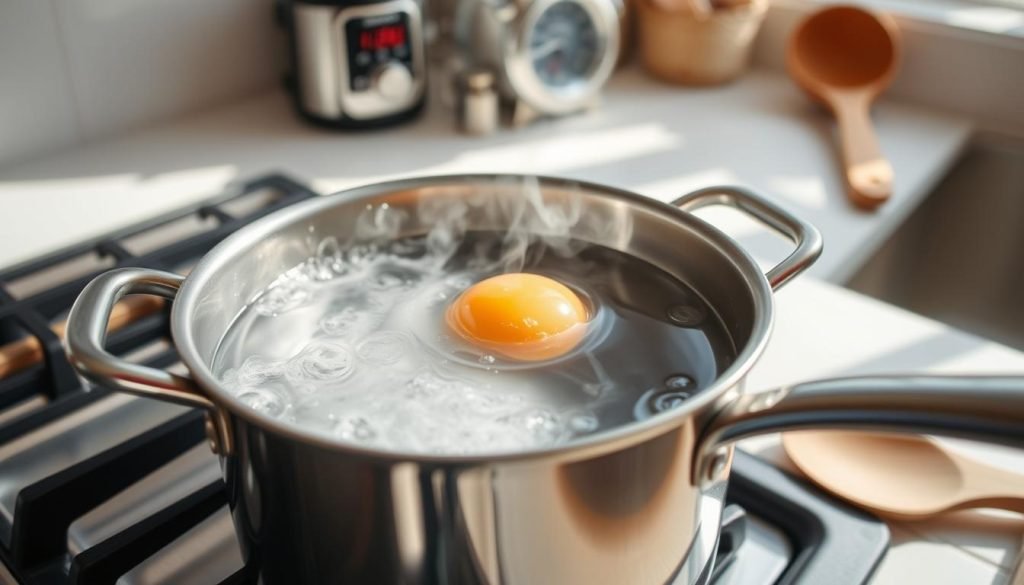Boiling Water Cooking Basics

Ever wondered why boiling water is a must-know for anyone in the kitchen? It seems simple, but doing it right is key for lots of recipes. From making pasta to getting veggies just right, knowing how to boil water can really up your cooking game.
Getting the boiling water cooking basics down is crucial for cooking all sorts of things. Whether you’re a newbie learning how to boil water or a pro, there’s always something new to learn. Boiling water isn’t just about waiting for bubbles. You’ve got to think about how full the pot is, the best temps for whatever you’re cooking, and how high you are above sea level.
Before we get into the trickier stuff, let’s cover the must-know skills. These kitchen essentials will give you a solid foundation. With them, you’ll be making tasty meals in no time.
Want to get better at basic kitchen skills, like boiling water? Let’s start this cooking adventure together.
Key Takeaways
- Mastering the basics of boiling water is essential for a variety of cooking techniques.
- Cooking pasta requires water to reach a full, rolling boil, typically at 100°C (212°F) at sea level.
- Salting pasta water involves adding about 1 tablespoon of salt per 4 liters of water.
- The ideal pot fill is no more than half to two-thirds full to prevent boiling over.
- Using a lid can reduce boiling time, making cooking more efficient.
Understanding the Science of Boiling Water
Boiling water is key in cooking. Learning the science behind it can up your cooking game. It involves how energy moves water molecules and how air pressure affects it.
How Heat Affects Water Molecules
Heat makes water molecules move faster. They bump into each other and share energy. This gets them to the boiling point, which is 212°F at sea level. When they move fast enough, they turn into steam. This lets us cook things well.
For example, short ribs cooked in boiling water get tender in three hours. In an oven, at 225°F, it takes more than eight hours.
The Role of Atmospheric Pressure
Atmospheric pressure changes water’s boiling point. At high places, like Mount Everest, water boils at just 158°F. That’s because the air pressure is lower. On Venus, with very high pressure, water would boil at a much higher temperature.
This means the boiling point changes with the pressure of the air. So, knowing this helps you cook better by adjusting for where you are.
Equipment You Need for Boiling Water
Boiling water is key in stovetop cooking. The right tools make it safe and efficient. Whether you’re new or skilled in the kitchen, picking the right pots and safety tools is vital.

Essential Cookware Items
A 4-quart saucepan is a must-have for small jobs, good for 1-4 people. For big jobs like soups, use an 8 to 12-quart stock pot. These pots are made from different materials like cast iron and glass, each with unique benefits.
- 4-quart saucepan for small to medium tasks
- 8-12 quart stock pot for larger volumes
- Sauté pans with high walls for multifaceted use
Add a good skillet or frying pan for frying and sautéing. These come in many sizes to meet all cooking needs beyond boiling water.
Recommended Utensils for Safety
Oven mitts are a must to avoid burns. Use wooden spoons for stirring. They won’t scratch pots or get hot.
- Oven mitts to prevent burns
- Wooden spoons for stirring without scratching pots
- Heat-resistant measuring cups for precise liquid measurement
A heavy-duty colander is key for draining pasta and veggies. Use collapsible prep bowls for space-saving. Also, have different cutting boards to avoid food mixing.
Getting these kitchen and safety tools will make boiling water easy and safe. It helps you be a better cook.
Different Methods to Boil Water
Boiling water is key in cooking. The way you boil water matters a lot. It affects how easy and effective your cooking will be. Knowing the details of methods like stovetop, electric kettles, or microwaves will guide you to better results.
Stovetop Techniques
Stovetop boiling is traditional and flexible. It allows for exact heat control. This is great for many recipes.
- Always use a pot that’s at least two-thirds full for boiling pasta or grains.
- Cover the pot with a lid to decrease boiling time by increasing the pressure within.
- At higher altitudes, the boiling point of water decreases, so boiling times will be longer. For example, at 10,000 feet, water boils at 194°F.
- Tools like slotted spoons or pasta inserts can minimize water splashing, enhancing safety.

Electric Kettles as an Option
Electric kettles boil water fast and with ease. They’re perfect for a quick tea or boiling small amounts of water.
- An electric kettle can reduce boiling time by pre-heating water closer to its boiling point.
- This method is particularly beneficial for those living at sea level, where water boils at 212°F, as it speeds up the entire process.
- Electric kettles often come with built-in safety features like automatic shut-off, reducing the risk of accidents.
Microwave Methods
Microwave cooking is another quick way to boil water. It’s especially good for just a bit of water. Always follow safety steps to avoid overheating and accidents.
Adding a microwave-safe object like a wooden spoon or a glass stir stick can help prevent superheating, which occurs when water exceeds its boiling point without forming bubbles.
- Use microwave-safe containers and avoid sealing them tightly to allow steam to escape.
- Heat water in short intervals, stirring in between, to ensure even boiling.
- This method can be particularly useful for quick cooking tasks such as blanching vegetables or rehydrating ingredients.
| Method | Advantages | Disadvantages |
|---|---|---|
| Stovetop Cooking | Precise temperature control, suitable for various recipes | Longer boiling times at high altitudes, requires constant supervision |
| Electric Kettles | Quick boiling time, built-in safety features | Limited to smaller water quantities |
| Microwave Cooking | Very fast, good for small amounts | Risk of superheating, uneven heating |
Safety Tips for Boiling Water
Boiling water safety is key to avoid accidents in the kitchen. It’s important to know the best ways to keep cooking zones safe. We will look at risks and give tips on handling boiling water safely.
Preventing Burns and Spills
Stopping burns and spills is very important when boiling water. The Bureau of Labor Statistics says burns happen a lot in places like restaurants. To cut down on burns:
- Always use protective gear like moisture-resistant, heat-proof gloves and splash-proof footwear for enhanced safety.
- Employ waterproof aprons to reduce splash-related injuries at cooking stations.
- Stand to the side when opening steam-generating equipment to lower the risk of burns from steam bursts.
- Install nonskid flooring or mats to reduce slip-related incidents and potential spills of hot liquids.

Carrying big pots of boiling water is risky. It’s safer to use carts or dollies for moving them. Safe cooking habits and good workflow can also make crowded areas less dangerous.
Using Boiling Water Safely with Cooking
To use boiling water safely in cooking, follow these steps:
- Ensure all containers are properly vented in microwaves to allow steam to escape, reducing the risk of burns.
- Keep flammable materials away from sources of open flames to prevent fire hazards.
- Use low-mounted microwaves to prevent risky reaching when removing hot food.
- Employ long-sleeved chef jackets for additional protection against forearm burns.
- Store leftovers in shallow containers for quick cooling and to avoid bacterial growth in the temperature danger zone of 40°F (4°C) to 140°F (60°C).
Using these safety steps can really help avoid accidents in the kitchen. Having quick access to fire extinguishers and first-aid kits is also crucial. These strategies make kitchens safer, cutting down the chance of burns and making cooking safer for everyone.
| Safety Measure | Impact on Boiling Water Safety |
|---|---|
| Use of Protective Gear | Reduces splash-related injuries and burns |
| Proper Venting in Microwaves | Reduces the risk of steam burns |
| Non-Skid Flooring | Prevents slip-related incidents and spills |
| Workplace Organization | Minimizes crowded conditions and improves workflow safety |
The Best Uses for Boiling Water
Boiling water is easy and ancient. You just need a pot and heat. It’s useful for many kitchen tasks. These include cooking pasta and grains, blanching veggies, and making instant drinks.
Cooking Pasta and Grains
To cook pasta well, start with boiling water at 212°F. Only fill the pot to three-quarters. This stops it from overflowing. Using a kettle makes it boil faster and saves energy. Stir slowly to prevent splashing.
| Step | Action | Tip |
|---|---|---|
| 1 | Fill the pot with water | Use a kettle to fill faster |
| 2 | Bring water to a rolling boil | A steady boil ensures even cooking |
| 3 | Add pasta or grains | Stir in slow motion to reduce splashes |
When done, drain with a colander. It sits in the sink. This makes dealing with hot water safe and easy.
Blanching Vegetables
Blanching makes veggies tender. Boil them briefly, then put into ice water. It keeps their colors bright and nutrients in.
- Boiling: Bring a pot of water to a boil.
- Boiling: Fill a pot no more than three-quarters full.
- Transferring: Carefully use a colander and an ice bath after boiling.

Making Instant Beverages
Boiling water is key for tea or coffee. A kettle heats water quickly and well. Make sure it boils for the best taste.
Boiling water helps in many kitchen jobs. From perfect pasta to tender veggies, it’s key. Using it right can make food delicious.
Flavoring Water for Cooking
Making your dishes taste better starts with the water you cook with. Learning to use things like simmering and adding flavors can really make your meals pop. This part will show you the best way to use salt, seasonings, and even herbs and spices.
Adding Salt and Seasonings
Most cooks believe not using enough salt is a big mistake. They say to salt your water until it’s “as salty as the sea”. This makes sure your dishes taste just right. Salt is great at bringing out flavors in foods. It makes everything taste better. Adding salt also helps in cooking methods like simmering, which make soups and sauces taste deeper and richer.
Infusing Herbs and Spices
Adding herbs and spices makes your food taste complex. For example, garlic, bay leaves, or thyme can make grains or pasta taste amazing. Mixing dried and fresh herbs balances earthy and bright flavors. Heat turns raw onions, garlic, and tomatoes sweet, adding interesting flavors. Some meals cook long, like a 7-hour Short Rib Ragu, while others, like Alfredo Sauce, take 40 minutes. The right herbs and how long you cook them can make your meal special.

Adding a bit of acid, like vinegar or lemon, changes seasoned boiling techniques. It brings out and balances flavors, making everything taste just right. By getting good at these methods, you can make everyday food into something amazing.
Common Mistakes When Boiling Water
Boiling water seems easy, yet common mistakes can mess up your cooking. Knowing these errors can lead to better food and no overcooking.
Overfilling the Pot
Filling the pot too much is a big mistake. If a 12-quart pot is more than ⅔ full, you’ll get spills. This creates a mess and makes boiling slower. It’s best to leave space for food without causing an overflow.

Too much water also affects cooking. Water takes longer to boil if the pot is too full. It usually boils in 5-10 minutes at 212°F. Stick to the right fill levels to avoid this issue.
Ignoring the Boil Time
Ignoring boil time is another error. Foods need different times to boil properly. Dried foods might need 5 to 15 minutes, while veggies for blanching take a few seconds to a minute. Not timing it right leads to food that’s not cooked right.
For example, veggies can turn gray if overcooked when blanching. Or, they might not be safe if not boiled long enough. Always use timers and watch carefully.
Also, where you live matters. Water boils at different temps based on altitude. It boils at 212°F at sea level. But, every 500 feet above that, boiling point drops by 1°F. So adjust your boiling times if you live high up.
Using these tips can help avoid mistakes and overdone food. Getting boiling right means paying close attention.
How to Know When Water is Boiled Properly
Knowing when water boils is key to good cooking. To master boiling, you need to spot boil signs and use the right methods. This makes your cooking better.
Understanding the Boil Indicators
Water hits boiling at 212°F (100°C) at sea level. But, it’s not just about temperature. Look and listen for clues. For example, bubbles are a big hint.
Bubbles appear around 160°F (71°C), but real boiling happens with big, active bubbles. At 205°F (96°C), you get a slow boil with big, lazy bubbles. Spotting these signs means you’re boiling right.

Checking Temperature with a Thermometer
For exact cooking, use a thermometer. About 30% of cooks skip it, relying on what they see. But a thermometer confirms water is boiling at 212°F (100°C). A great digital thermometer makes cooking exact and easy.
| Boiling Stage | Temperature (°F) | Description |
|---|---|---|
| Initial Bubble Formation | 160°F | Early bubbles form, not boiling yet |
| Slow Boil | 205°F | Large, slow-moving bubbles |
| Full Boil | 212°F | Vigorous, rolling bubbles |
Using these signs and tools makes you a boiling pro. Your dishes will turn out just right.
Boiling Water for Baking and Cooking Prep
Boiling water is key for prepping food, especially in baking. It cuts cooking times and improves texture.

Prepping Ingredients with Boiling Water
Boiling water is crucial for food prep. For example, adding a 1% salt solution speeds up boiling. It helps in blanching vegetables to keep their color and nutrients. Pre-boiling veggies like potatoes shortens cooking times, important for timely recipes.
How it Affects Cooking Times
At sea level, water boils at 212°F. This high heat speeds up cooking. For instance, pasta cooks in 10-15 minutes, and eggs in 6-7 minutes. Boiling makes tough meats tender fast due to consistent heat. At higher altitudes, water boils at lower temperatures, so cooking takes longer.
Using boiling water in baking helps speed up cooking. It also improves texture and consistency in baked goods. This knowledge leads to better cooking results.
Environmental Considerations When Boiling Water
It’s important to think about the planet in our everyday actions. Boiling water can make a difference. Using less energy and water helps our earth.

Water Conservation Tips
Saving water is key today, with many places facing water shortages. Only boil the water you need. A lid on your pot keeps water from escaping as steam. This saves water and keeps your food rich in nutrients.
Try to use boiling water more than once. You can use it for cooking again or to water plants. This is a step towards greener habits.
Energy Efficiency in Cooking
Choosing the right pots and cooking smart saves energy. Use cookware that fits your burner. Electric kettles boil water quicker than stoves, saving power.
Don’t boil water too long. Use a timer to get it just right. This saves energy and keeps water clean.
Below is a table with advice for saving water and energy while cooking:
| Tips | Benefits |
|---|---|
| Measure the exact water needed | Reduces water waste |
| Cover the pot with a lid | Minimizes evaporation |
| Reuse leftover boiling water | Promotes eco-friendly cooking practices |
| Use appropriate cookware size | Prevents energy wastage |
| Utilize high-efficiency appliances | Saves time and energy |
| Set timers for precise boiling | Ensures efficient energy use |
Conclusion: Mastering Boiling Water Cooking Basics
Mastering how to boil water is more than just a basic kitchen task. It’s a key skill that can greatly improve your cooking. It involves knowing how heat changes water and how air pressure affects boiling. The right pots, pans, and safe habits make boiling water easy and safe.
Recap of Key Points
You’ve learned about stovetop, electric kettles, and microwave boiling methods. We gave safety tips to avoid burns and spills. This guide showed how to safely boil water for cooking.
We also talked about using boiling water to cook pasta, vegetables, and instant drinks. Adding salt, herbs, and spices to boiling water can enhance your food. These tips help build your cooking skills and allow for kitchen experiments.
Encouragement for Practice and Experimentation
As you keep cooking, remember that practice makes perfect. Trying different boiling methods will strengthen your knowledge and confidence. Understand the science of boiling water to improve your dishes.
Mastering boiling water can open doors to more cooking skills. It turns simple meals into special dishes. Keep boiling, and enjoy your cooking journey!